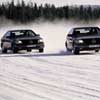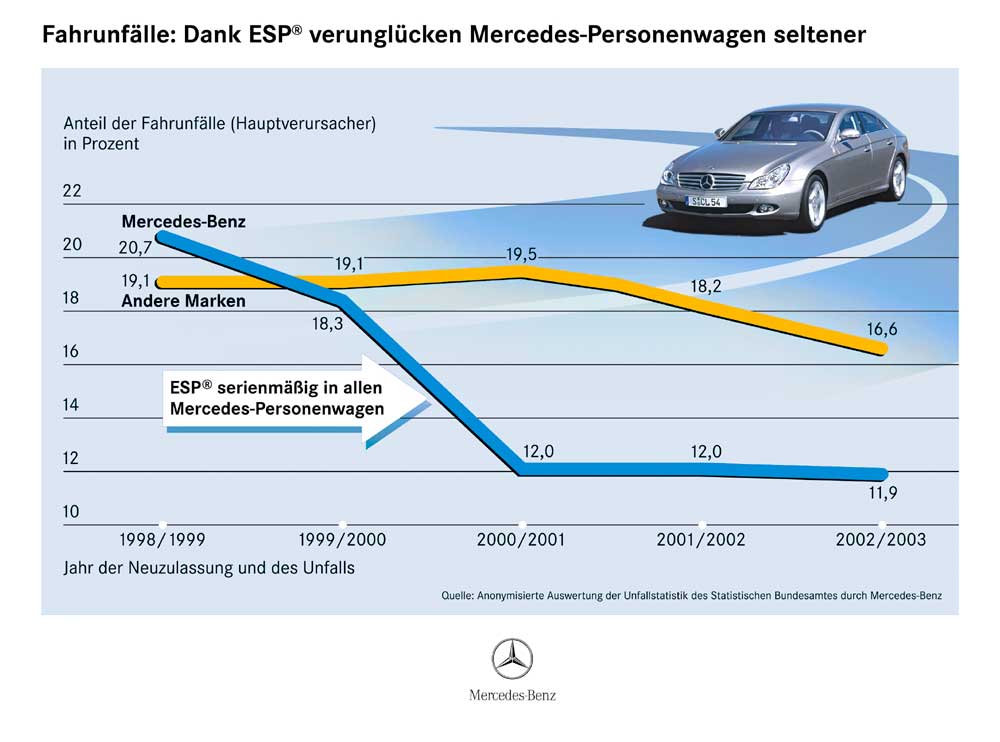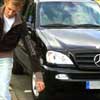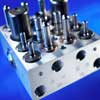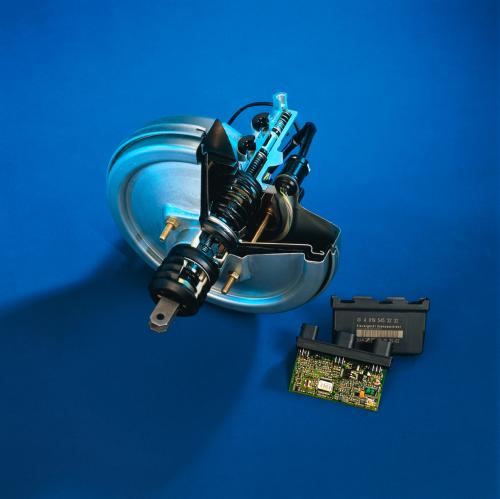The dream pursued.
Continued from ABS.
Continued from 4MATIC®.
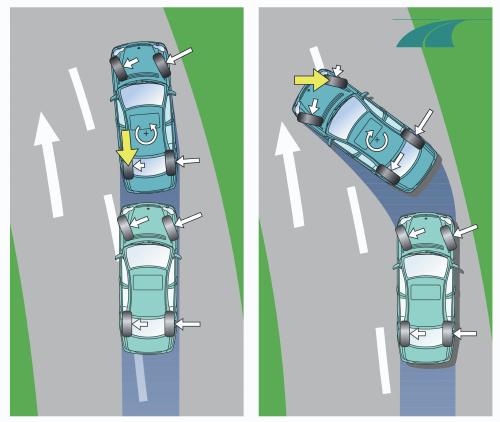
Mercedes-Benz |
ESP® in action ESP holds cars on a steady course: During understeering (left picture) the front wheels turn outward; ESP automatically applies the brake to the inside rear wheel. When the rear end breaks away during oversteering (right), ESP brakes the outside front wheel.
|
Mercedes-Benz ESP® or ESC Stability Control
So far we talked about longitudinal slip. The obvious next
question: What about sideways motion?
And thus ESP was invented which controls the car's sideways
motion by pulsing individual wheel brakes.
Several sensors are used: ESP shares the wheel speed sensors with a four
channel ABS system and in addition employs a steering angle, yaw
rate, brake pressure and sideways acceleration sensor. From these
inputs two variables are calculated and internally compared to expected
values, derived from a bicycle model: the yaw rate and the side slip angle.
Controlling the yaw rate alone was found to be insufficient. Whenever a
discrepancy is detected, individual wheel slip controllers are actuated,
also known as disk brakes, to bring the wheel back to its desired ratio,
and the vehicle back onto its intended track.
ESP works in all regimes like: acceleration, coasting, light braking, hard braking, engine drag and load shift and enhances vehicle stability even during extreme steering maneuvers (panic reactions).
I prefer to think of ESP® as a steering instead of a braking system.
Which wheel will be braked?
In general when oversteering - fishtailing - the outside wheel or wheels will be braked.
When understeering - plowing - the rear inside wheel will be braked preferably. But other
combinations are possible. ESP is flexible. It also depends on the version of the system.
How can I test ESP?
Find a large flat surface, like an empty parking lot or frozen lake.
Then drive the car close to the critical speed with ESP OFF and ON.
I have listed some speeds for a 300 foot diameter circle:
| surface |
adhesion coefficient |
critical speed |
| black ice |
0.1 |
15 MPH |
| packed snow, gravel |
0.2 |
20 MPH |
| wet asphalt |
0.5 |
30 MPH |
| dry asphalt |
0.8 |
40 MPH |
Black ice is also called "surface ice", a thin ice layer on the road, bridges etc.
For testing low traction surfaces are preferred for two reasons, to keep the speed low, and drifts are much easier to control, particularly on packed snow. The closer one gets to the critical speed, the more difficult it is to keep the car under control without ESP. Once ESP is on, it's pretty easy to drive right at the physical limit, and it follows the drivers intention within limits (steering wheel, acceleration, braking). In this regime ESP is using side-slip control which means it tries to steer via individual wheel braking into the direction to which the driver points the front wheels via the steering wheel.
Does ESP work on polished ice?
Yes. Bosch showed in the beginning of 1987 that a test
vehicle equipped with ESP and slip controllers at the wheels, can even be
stabilised during full force braking on polished ice surfaces,
and using a volume produced ABS controller.
What is the ESP threshold?
Here's the skidpad experiment again, donuts in a parking lot.
In a 300 ft circle on packed snow the critical speed is about 20 MPH.
The ML with ESP ON or OFF behaves the same until about 19.5 MPH. With
ESP ON at 19.5 MPH the warning triangle may flash and individual wheels
are braked to keep the side slip to a minimum, and ESP may refuse more
throttle to keep the ML inside the stable regime.
Now, with ESP switched OFF, one can increase the speed a bit further
and the triangle may not flash until close to 20 MPH.
Demands for steering inputs increase drastically, the driver sweats.
It's a lot of work to keep the car on the pad at the limit, while
the guy with ESP just cruises by, smiling.
If the limit is exceeded, the rear breaks away, one must countersteer
or spin out and leave.
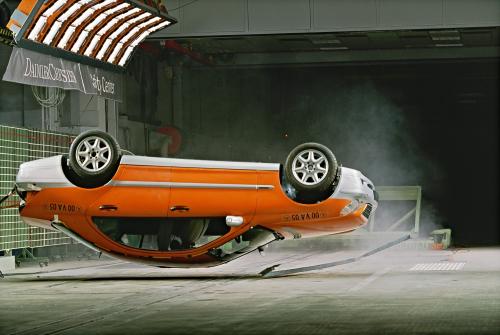
Any more advanced test suggestions?
One can try those used for ESP vehicle testing: braking in a curve,
fast S-curve, double lane change (the "elk-test"), obstacle avoidance:
full braking during lane change, and a series of fast S curves on packed
snow with a 40-45 MPH constant speed.
ESP works at any vehicle speed and is only limited by the response of the system, which is rather fast. In the ML it can activate 150 times per second. And braking latency is much lower than either engine or drivetrain latency, which makes the brakes the best, maybe the only?, method to handle fast dynamics.
|
|
Does ESP work while the vehicle is braked?
ESP® forces when braking
|
What does the ESP off switch do?
It disables the engine-torque-reduction capability
and thus reduces the computers' intervention capabilities to about 20%.
How do I know ESP is working?
The center triangle in the speedometer flashes when ESP
intervenes. Flashing at low speeds
is usually caused by 4ETS, but flashing above the 4ETS limit speeds is
caused by ESP. For example, on a 1'20" dry and wet concrete slalom track,
with an initial entry velocity of 100 MPH, the minimum speeds through a series
of S turns were between 35 to 40 MPH, mostly higher. ESP was switched
off, the warning triangle light solid on. It flashed off about
2 to 10 times per run, with 1 to 16 flashes each, depending on the
smoothness of the driver. The speedometer was taped to record speed
and flashing. Under these conditions only ESP flashes the light.
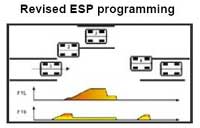 |
Is ESP® too intrusive?
|
Active Yaw Control (AYC)
Yaw can also be controlled actively by drive torque instead of
using the brake pulses. In the Mitsubishi Lancer EVO 6 introduced in
1996 torque is directed laterally from the rear differential to the
wheels on either side, creating yaw moments. Honda introduced a
similar system, super handling all wheel drive, SH-awd, in 2004.
Dry-brake function
Some ESP systems also offer a dry brake function: in adverse
weather conditions, the system wipes water off the brake discs at
regular intervals by briefly applying the brake pads.
What is trailer stability assist?
TSA reduces trailer swaying by utilizing ESP sensors and braking
systems and was introduced in 2005 with the W164 M-Class.
TSA is an extra function incorporated into the ESP® Electronic Stability
Program that is designed to offer drivers even greater safety
when towing a trailer. TSA is capable of detecting the dreaded
fishtailing motion swiftly and nipping it in the bud effectively.
To do this, it pulses the front left and right brakes individually and alternately
to stabilise the car/trailer.
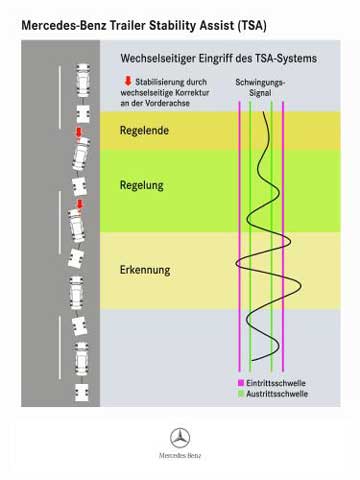
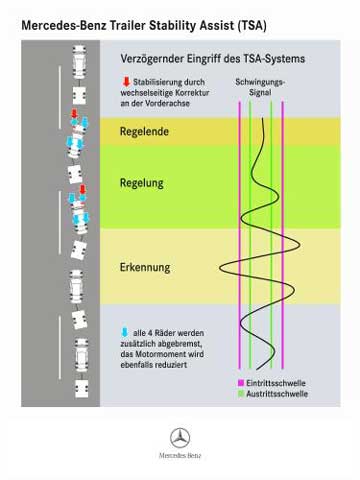
What's 4ESP?
ESP together with 4ETS all wheel drive is called 4ESP, presently the
most advanced traction control system offered by Mercedes-Benz.
4ESP is standard on the 1999 M-Class and an option in E320 models.
The hydraulic modulator can be found in the engine compartment with 4ESP
stamped on it. The master control unit right next to it is labeled 4ESP MCU
and is interfaced to the traction controller in the sturdy vented E-box.
Who invented ESP®?
Frank-Werner Mohn built a first prototype at Mercedes-Benz, after landing in the ditch
in Sweden in 1989. Anton van Zanten at Bosch, who worked on ESP already
at Cornell in 1973, with a thesis titled "Optimal Control of the Tractor-Semitrailer Truck"
and Armin M Müller at Daimler-Benz were the project
leaders. ESP work at Bosch started in 1982 and after development
under full braking within ABS, then during braking outside ABS,
then free rolling and then within ASR was finished, in 1992 teams
from Bosch and Daimler-Benz of about 40 engineers moved into a
common building to develop ESP for the S-Class.
ESP world premiered in 1995 on the 12 cylinder Mercedes
CL600 coupe and S600 sedan as standard and was optional for $1200 to
$1500 in other W140 S-Class models, the S420 and S500.
The inventors received the Society of Automotive Engineer's
Henry Ford II award in 1995 and the Porsche Preis of the TU Wien in 1999.
In 2007 Bosch received the FIA World Prize for ESP.
Does ESP® reduce accidents?
|
More info
Original press release announcing 1999 Mercedes M-Class with ESP
Critical Driving Conditions Are Avoided Right from the Start
ESP Simulator Event to be Held At BEI Systron Donner, 2003
Insurance Institute for Highway Safety status report 6/13/2006
NHTSA Statistical Analysis of the Effectiveness of Electronic Stability Control (ESC) Systems July 2007
ESP for New Mercedes-Benz M-Class
Mercedes-Benz Australia - Introduction - Wheels - Active Safety Program, January 2007 issue
ESP® on all cars
MBUSA: "ESP® Stability Control to be Mandated for All Cars", Sep 14, 2006
Bosch Supports NHTSA Proposal to Require Electronic Stability Control on All Vehicles, Sep 15, 2006
Continental Lauds U.S. Federal Requirement that Mandates Electronic Stability Control, Apr 5, 2007
Bosch: EU Commission, FIA, and Euro NCAP recommend: No car without ESP®!, May 8, 2007
Brake Assist System (BAS)
When BAS is integrated with ABS the pedal feel may change, just like with power brakes. It's usually slightly softer and precise and pedal pulsing when entering the ABS control regime may be less pronounced. I find that the pulses at the ABS onset are softer, but become pronounced towards the end when the vehicle approaches a full stop. Rear end crashes decline 8% and pedestrian accidents decline 13%. |
Active Body Control (ABC) compensates crosswinds
Mercedes-Benz developers added a crosswind stabilisation function to
Active Body Control (ABC). For this purpose
ABC uses the yaw rates and lateral acceleration sensors of the Electronic
Stability Program ESP® to vary the wheel load distribution via
the ABC spring struts, depending on the direction and intensity of the
crosswind. This enables the effects of crosswinds to be compensated,
or reduced to a minimum in the case of strong gusts. Daimler estimates
this will reduce accidents by 1-3% from EU data. Crosswind stabilisation
became standard on the S600 in 2009 and AMG calibrated ABC.
Lateron the crosswind assistant without ABC also makes counter-steering by the driver in sudden gusts no longer necessary - and thus significantly relieves the driver. The crosswind wizard is software based, extending the standard electronic stability program ESP. In the Sprinter the new system is active from 80 km/h on up to top speed. Through sensors the system detects the yaw rate and lateral acceleration in crosswinds and gusts. Mercedes-Benz has set a maximum lateral displacement of 50 centimeters as objective, which even with fierce gusts should not be exceeded. The sensors also register the angle of attack and include vehicle speed, loading condition and loading position and the steering behavior of the driver; if the driver countersteers manually the wizard will retreat automatically. The ESP based crosswind assist became available in 2013 on the GL and Sprinter with other models to follow.
Torque Vectoring Brake
Similar to the individually optimised braking forces in SBC, the Torque Vectoring Brake
provides the 2009 S-Class with added safety in critical conditions and
even greater agility by specifically braking the inner rear wheel in bends
so as to enable precise cornering by the saloon without compromising on
driving dynamics.
Torque Vectoring Brake
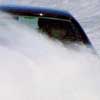
|
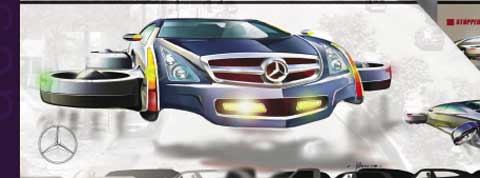
|
The Future
More control through algorithms optimised for different driving situations and
adaptive for example to cargo payload.
Refined brake controller valves with quadruple digital states were introduced in 2000 and analog valves followed in 2004. Pressurisation in stages offers advantages, with or without inclusion of the booster or enhanced return pump; and often integrated with brake assist BAS. Electro-hydraulic or electric calipers may be integrated with regenerative braking on hybrids.
More axis might be added. For example sensing and controlling the roll rate with integrated multi-axis roll and yaw sensors (first introduced on the Volvo XC-90 in 2002). Or yaw, roll and pitch. And a helicopter axis to recover from quicksand. Let the tires jump over the potholes instead of diving into them, like in the F700.
An algorithm to control ESP on a vehicle with a locked center diff when the driver is braking was patented.
Steer Control: Coupling ESP® with steering via a refined algorithm varies the steering assist ratio thus reducing the need for ESP intervention e.g. when correcting over- or under-steering, or when braking on mµ-split surfaces. First introduced with the new A- and B-Class.
Tighter integration of braking, chassis and suspension systems promises to enhance performance and safety. For example in the 30 meter car ultra short braking distances were achieved. Coupling with active body control or active steering assist systems, e.g. in the ESP 2 prototype in March 03 enhanced driver competence and control.
The TelePorter is expected in 3014.
created in 1998 and updated from time to time
|
"ESC is arguably the most important motor vehicle safety advance of our generation." Joe Gaus |
